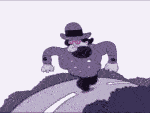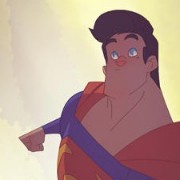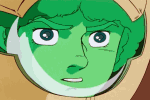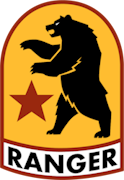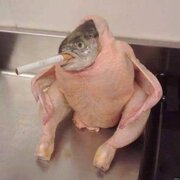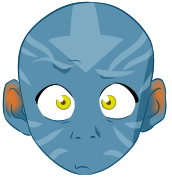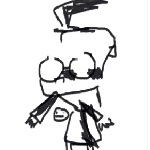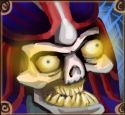|
The Silver Snail posted:Would Olaf smoke in the adult version of Frozen. Some things are worth melting for 
|
|
|
|

|
| # ? Jun 7, 2024 10:01 |
|
Yeah I think “it’s for kids” is a good shorthand for “stop overthinking the worldbuilding irrelevant to the theme of the story,” ie, someone getting really hung up on the improbable biology of The Little Mermaid. But it’s not a good way to handwave shoddy quality in general. Good movies are good movies, doesn’t matter if they’re for kids.
|
|
|
|
Animated movies are evaluated by their gimmickry rather than by their artistry. This is why culture has largely passed by two of the greatest CGI animated movies ever made, Steven Spielberg’s Adventures of Tintin: The Secret of the Unicorn, and Zack Snyder’s Legend of the Guardians: The Owls of Ga’Hoole, in favour of the Disney-Pixar-Dreamworks assembly line (maybe having to type out those titles one time too many got to pop journos). It is a startling thing to realise that Owls of Ga’Hoole still looks better than almost any animated movie after it (and certainly better than before it). In the case of both movies, a director known previously for live-action movies and visual innovations decided to dabble in animation. The problem with most animated movies is that they have no real directors: John Lasseter, Brad Bird, and the half-anonymous, interchangeable cliques are animators first and directors second. The role of a director is to manage a project to achieve their artistic vision, and these animation directors have all the necessary skills but no vision to accomplish. They became directors because they were company founders or because they rose up the ranks – a model of art as technocracy. Their animated movies seem to come out the imagination of committees rather than of artists. Animal Logic, the animation company behind The Owls of Ga’Hoole also worked with Mad Max director George Miller to create Happy Feet and earlier provided visual effects for Babe. This is only further evidence that no clique of animator-technocrats is match for partnerships with seasoned directors. Snyder and Spielberg managed advance animation more than the professionals of the medium. Because they do not take the aesthetic potential of animation for granted, they can work at creating something that looks interesting.  The art design The Owls of Ga’Hoole has the advantage of being free of commercializing influence – almost every character in children’s animated movies is created made with their toyetic possibilities in mind. The inhabitants of Ga’Hoole, along with the artistically ugly cast of 2011’s Rango (another animated film directed by a non-animator) are among the rare exceptions. Liberated from the impulse to simplify and streamline, the artists can fully embrace the potential of digital animation for complex and intricate designs. They have the licence to make the characters look beautiful, something that few animated movies attempt. The movie’s owls are not infantilized toy prototypes, but faithfully recreated animals who remain alien enough to be intriguing even when anthropomorphised. Although animated, the word of Ga’Hoole is not a cartoon universe. Matter and laws of physics do not warp, and the owls always retain their realistic sense of physicality while hopping, flapping their wings, gliding, and clawing. The characters are anthropomorphised through their bright, absorbing eyes that express their character. The protagonist Soren’s brown eyes, for example, are narrow but always stretched open to emphasise vulnerability and immaturity, while his brother’s eyes occlusive eyes indicate an absence of empathy. The two lunatic friends who Soren have sharp and flatly monochromatic gaze to show that they’re not quite all there, while a pair of idiot henchmen have patchwork eyes as colourful as a fool’s motley hat. And each owl has their down coloured with sumptuous natural shades. The wondrously realised birds glide through a dream-world (partly Australian-inspired) perpetually lit by the soft glow of dusk and twilight.  Because animated movies are evaluated for their gimmicks, they are mostly remembered for particular sequences, plot twists, or quirks of their style. This is for example why some adults are strangely excited by death and violence in children’s movies, since the idea of transgressive brutality (and the world “brutal” tends to be thrown around) serves as an interesting gimmick for them. Other times viewers simply stick to particular songs or ,as is common with Pixar movies, recall the scenes transparently meant to pull on heart-strings. But nothing in Ga’Hoole stands out in particular because everything in it stands out. Dreamworks’s Kung Fu Panda 2 has a show-stopping sequence where the hero manipulates a single water-drop in search of inner peace. Ga’Hoole features essentially the same scene but far superior, as the hero flies through thousands of rain-drops like glittering diamonds. This spectacular moment is a relatively minor part of the story. Similar neglect of craftsmanship by audiences can be observed in The Adventures of Tintin: viewers tend to remember best the chase sequence in a North African port city, but ignore that every scene is just as amazing despite being on a smaller scale.  In terms of psychological depth, Owls of Ga’Hoole is far ahead of the competition. American and Western children’s movies in general have throughout their history been largely concerned with struggle for reconciliation, and this is especially true for animated movies. The stories of Disney and Pixar are a history of reconciliations, between friends, between enemies, between adults and children, humans and animals, individuals and society, the living and the dead, etc. – which ideally culminate in heart-warming reunions. But there is something false about this overriding focus on emotional healing. Film-makers rely on formula and seem to have forgotten how to portray emotional, social, and psychological development in children’s movies. There are few CGI releases that convincingly portrays growth, certainly not from Pixar or Disney. Not so with Owls of Ga'Hoole. The story is about two children who grow by choosing between good and evil. Soren and his brother are young owls still incapable of flight and raised on stories of the Guardians, legendary warrior-owls who protect the weak. After stumbling out of their tree, the two are kidnapped by the fascistic Pure Ones, one becoming a slave and the other a child soldier. Soren’s faith in the Guardians lead him to endure and join their ranks after he escapes. His brother Kludd’s resentment and cowardice leads him to sell his soul to the abominable Pure Ones, even as Soren braves danger to rally the Guardians. There is no room for reconciliation between good and true evil. The fratricidal conflict between them makes the battle of the Guardians and the Pure Ones both personal and mythical.  The battle between brothers on opposing sides brings to mind Dreamworks Animation’s Prince of Egypt, which before Owls of Ga’Hoole was probably the last animated American movie to truly portray a struggle between good and evil. Since animated movies are so preoccupied with the idea of reconciliation, the role of evil is to be a plot-initiator, or complication, or an obstacle to happiness. In Owls of Ga’Hoole, evil is a force in itself. The Pure ones are, without any ambiguity or obfuscation, given the ideas of fascists (“Remember, weakness is for the lower species, never for us.”) and the methods of warlords (“Some of you will be pickers. Some will be soldiers.”). The movie does not dwell on their viciousness to portray them as evil, and rather illustrates shades and gradations of evil in a way that shames most “adult” stories. The kidnapped owlets are given a welcoming speech lamenting how they have been abandoned by their families but declaring that they have a new one in the Pure Ones. The lie is so transparent that even its teller cannot bring much enthusiasm to it, providing an example of evil as banality. Nyra, the second-in-command of the Pure Ones, meanwhile not only has the unshakeable self-confidence of a true believer but also the intelligence and eloquence to seduce others to her cause – evil as fanaticism.  Soren’s brother Kludd chooses to join the Pure Ones as a soldier rather than accompany Soren into slavery and eventually into freedom – evil as cowardice. Metal Beak, the monstrous leader of the Pure Ones, illustrates evil as sadism and a traitorous Guardian chooses evil out of opportunism (like the Spartan fifth column in 300). The shades of evil have their heroic counterpart, even if the rushed pace does not allow the movie to fully do justice to them. Thus its portrait of evil is more convincing than its portrait of good, though not for a lack of effort. Soren’s fantasies of heroism form the story’s moral framework even if they are poorly visualized, though their insubstantiality might be the point. When he finally discover the Guardians and tells that others were with him, their queen tells him that they already know. It is the confidence and competence that we wish to hear in crises. The king and queen treat the escaped children with understated but profound kindness and patience that summarises their noble idealism.  The king and queen, despite their slim roles, are the kind of adults that inspire trust and faith in children, but such figures are so rare these days that the movie is already making great strides by including them in the first place. Lyze of Kiel, on the other hand is the kind of adult most able to teach children. Soren’s hero turns out to be diminutive and haggard grouch who is not impressed by a child who play-acted the wars in which he himself fought. Dialogue such as the following is impossible to imagine in animated movies by Disney, Pixar, or Dreamworks: “Well, this is what it looks like when you’ve actually fought in battle. It’s not glorious, it’s not beautiful, and it’s not even heroic. It’s merely doing what’s right. And doing it again and again, even if someday you look like this.” Even the last studio’s Prince of Egypt would shy away from it. Zack Snyder is able to use the animal characters to abstract violence, focusing on moral confrontation rather than dwelling on transgression. 2018’s overrated Spider-Man: Into the Spider-Verse (which shows that non-animator directors don’t always make good animated movies) tried to express a similar ethos, but It rang obviously false because no one involved knew what it means to do the right thing. It does not mean fighting trivial comic book baddies. But as in the Avengers meta-franchise, the number of superheroes in Spider-Verse increases the to compensate for the lack of any genuine heroism. This is why it’s platitudes about “getting knocked down and getting back up” were just platitudes. Zack Snyder later expanded on Lyze of Kiel’s speech with Man of Steel, the greatest superhero movie ever made, whose insistent truthfulness in portraying the pain of heroism was met with virulent opposition. This all makes Owls of Ga’Hoole sound terribly serious, which it is, but it has more bright light and wonder than darkness. The script’s approach to comedy deserves some attention. In general, most clichés of animated comedy are avoided. There is no overload of sarcasm as in so many other movies. A pair of idiot henchmen are introduced early on, and after they’ve served their role, they fade into the background. There is no scene where they receive their humiliating comeuppance, one that other filmmakers might feel to be absolutely necessary.  Early in the movie, the hero’s little sister regurgitates her first pellet, and in any other’s animated story this would be a set-up for a later scene where someone resolves a problem by ejecting a pellet out of their guts. This simply never happens in ]Owls of Ga’Hoole. The restraint at work deserves all possible praise. Another example of avoiding a tiresome joke is that there is no moment where the owls ridiculously twist their neck backwards. This real Strigiforme behaviour is such obvious comedic opportunity that only someone exceedingly disciplined would choose to ignore it. Some obligations cannot seem to be avoided, though, and the low point of the movie comes when the heroes are introduced to the Harry Potter-inspired society of the Guardians in a montage set to a pop turn that serves only to remind the viewer that the movie is based on some cruddy book series. The setting is vaguely sketched in general, and today it would face pseudo-criticism over “bad world-building”. The part is however redeemed by wonderful imagery. The story has its share of comic relief characters, but these characters are not clownish: they have no propensity for slapstick or for cracking jokes. They are comical because they appear to be out of touch with reality, while the chief heroes and villains remain unflappably earnest. This gives the movie’s humour a nervous aspect, and if anything, the comedy underlines the movie’s pleasant gravitas. Zack Snyder, with his co-screenwriters, is able to characteristically tell a serious story where the humour never deflates the action. It’s a trademark for Snyder’s movies: being weighty without ever overburdening the audience, except the hyperventilating online types for a movie “taking itself too seriously” is a mortal sin. Owls of Ga’Hoole unfortunately shows how it is possible for a great movie to not leave any impression on its audience whatsoever. The movie is ten or fifteen minutes too short, and never has quite enough time to plant its themes and let them grow naturally. The characters are constantly moving, discovering things, or fighting, which means that there’s hardly a single “quiet” moment in the whole movie. There are plenty of worse movies with worse stories and messages, but they are more successful because they delivered those worse stories and messages much more effectively. The movie is a masterpiece, but one that demands some graciousness on the part of the viewer come meet it halfway through to fully appreciate it. This is a tall order with family audiences who simply want to be have fun. But those willing to forgive the rushed pace and sometimes slim characterization will be rewarded with a movie that ranks among the highest achievements of CGI animation. BravestOfTheLamps fucked around with this message at 08:13 on Mar 9, 2019 |
|
|
|
what the christ
|
|
|
|
The Silver Snail posted:Would Olaf smoke in the adult version of Frozen. Maple Syrup vape, and he does not shut up about it. You know it's true.
|
|
|
|
Neon Noodle posted:what the christ This is the animation thread for discussing animation.
|
|
|
|
I thought BravestOfTheLamps posted:The Owls of Ga’Hoole
|
|
|
|
It did give us the excellent word “Ga’hooligan” to describe an owl enthusiast though
|
|
|
|

|
|
|
|
Hedrigall posted:I thought Like I said, people have been primed to think of animated movies on the basis of gimmicks. Because the movie has nothing that could serve as a gimmick, people forget it.
|
|
|
|
That's a stretch
|
|
|
|
Ga'hoole is gorgeous, but the plot and characterizations are poor. Tintin is, however, legitimately very very good and weirdly overlooked.
|
|
|
|
There's nothing wrong with the movie's plot and characterization except being rushed.
|
|
|
|
Pick posted:Tintin is, however, legitimately very very good and weirdly overlooked. It'd be like expecting the Condorito movie from Spanishland to get acclaim. I wonder what the Peanuts movie was like. I remember the trailers making it look like it was soft materials everywhere for some reason.
|
|
|
|
The Peanuts movie wasn't bad, pretty cute but kind of drags in places
|
|
|
|
I have no idea why you posted that many words that are objectively wrong, but okay.
|
|
|
|
FilthyImp posted:Tintin mever had a strong fanbase in America, so it's not crazy that it was overlooked. You'd have to convince parents to go and take that chance vs whatever Minions or Disney film is around at the moment. I loved Condorito growing up and agree. Also, can someone cliff notes that post because while fascinating it's quite long.
|
|
|
|
I really don't want to spend too much time replying to Lamps, but I do want to say that the idea that live-action directors are somehow superior to animated film directors is hilariously laughable.
|
|
|
|
Acebuckeye13 posted:I really don't want to spend too much time replying to Lamps, but I do want to say that the idea that live-action directors are somehow superior to animated film directors is hilariously laughable. They’d be very disparate skill sets. Like live actors and voice actors.
|
|
|
|
I like it more when animation directors jump on live action. Ghost Protocol has so much kinetic energy in it. Shame Bird couldn’t keep that up with Tomorrowland.
|
|
|
|
One thing I'd say in favor of that idea is that live action directors have a chance of not learning certain preconceived notions about what animation "should/shouldn't" be, kinda an outsider art thing... but there are also a lot of live action directors who have the "general public" preconceived notions about what animation "should/shouldn't" be that directors specialized in animation either lack or outright push against Plus Spielberg does have some involvement in animation in the past (generally as a producer, but still); there are def differences between the Tom Ruegger shows that fall under the Steven Spielberg Presents label (like tiny toons, animaniacs, pinky & the brain) vs the ones that aren't (like road rovers and histeria) Digamma-F-Wau fucked around with this message at 01:14 on Mar 9, 2019 |
|
|
|
Acebuckeye13 posted:I really don't want to spend too much time replying to Lamps, but I do want to say that the idea that live-action directors are somehow superior to animated film directors is hilariously laughable. Ga'Hoole and Tintin, CGI movies by primarily live action directors, are all superior to CGI movies by animator-directors. Professional animators have made dozens of these movies and got upstaged by dabblers. In fact, most big movie today are de facto CGI animated. Animators don't have a particular advantage in directing. BravestOfTheLamps fucked around with this message at 01:17 on Mar 9, 2019 |
|
|
|
BravestOfTheLamps posted:Ga'Hoole and Tintin, CGI movies by primarily live action directors, are all superior to CGI movies by animator-directors. Yeah I can buy that in some respects good CGI and good hand-drawn animation do have a lot of needed touches to make them "good" that are different from each other. I'd totally be down for living in a world where the canon of CGI films makes films of Spiderverse's quality be seen as "decent" rather than "near the top"; Spiderverse was great (and I guess semi-supporting Bravest's point, the main producers have experience in directing both live action and animation while one of the directors was a live-action writer), but it would be nice to get films even better than it also bring back theatrical 2D animation
|
|
|
|
Phylodox posted:They’d be very disparate skill sets. Like live actors and voice actors. I'd argue yes and no. There's strengths to each medium, but there's plenty of crossover skills in terms of actual direction and cinematography that both live action and animation rely on—shot composition, set design, use of color, etc. There's a really cool post here, for instance, that talks about the cinematography of The Incredibles that can easily be used to examine technique in any film. CelticPredator posted:I like it more when animation directors jump on live action. Ghost Protocol has so much kinetic energy in it. Shame Bird couldn’t keep that up with Tomorrowland. George Miller actually began work on Mad Max: Fury Road by storyboarding it like an animated film, which was a major part in designing the film's flow and constant kinetic action. Digamma-F-Wau posted:Plus Spielberg does have some involvement in animation in the past (generally as a producer, but still); there are def differences between the Tom Ruegger shows that fall under the Steven Spielberg Presents label (like tiny toons, animaniacs, pinky & the brain) vs the ones that aren't (like road rovers and histeria) Keep in mind too he was heavily involved in An American Tail and The Land Before Time. Calling his involvement 'dabbling' is honestly kind of an insult to the decades of involvement he's had in the medium.
|
|
|
|
Acebuckeye13 posted:George Miller actually began work on Mad Max: Fury Road by storyboarding it like an animated film, which was a major part in designing the film's flow and constant kinetic action. a lot of action films involve storyboards: Bryan Andrews (an animator on Iron Giant, one of the main storyboard artists on Samurai Jack, and co-creator/storyboard supervisor on Symbionic Titan) has done storyboards for a lot of Marvel films, for instance the whole situation's pretty neat
|
|
|
|
Digamma-F-Wau posted:a lot of action films involve storyboards: Bryan Andrews (an animator on Iron Giant, one of the main storyboard artists on Samurai Jack, and co-creator/storyboard supervisor on Symbionic Titan) has done storyboards for a lot of Marvel films, for instance Why do they look like garbage then?
|
|
|
|
BravestOfTheLamps posted:Why do they look like garbage then? well he's not the only storyboard artist on them, plus Marvel films are pretty corporate, can't be too off the beaten path (storyboard artists are usually not involved in color either)
|
|
|
|
A short list of CGI movies inferior to Ga'Hoole and Tintin: - every Pixar movie - every Disney CGI release - every Dreamworks CGI release
|
|
|
|
Digamma-F-Wau posted:well he's not the only storyboard artist on them, plus Marvel films are pretty corporate, can't be too off the beaten path (storyboard artists are usually not involved in color either) It's almost like live-action directors aren't inherently better at utilizing animation! 
|
|
|
|
at least Lamps hasn't gone full contrarian and stated Spiderverse is worse than those two yet
|
|
|
|
Re: Animation Thread 2K19: Thanks, I Hoot It.
|
|
|
|
Digamma-F-Wau posted:at least Lamps hasn't gone full contrarian and stated Spiderverse is worse than those two yet I'll also note that his list specifically excluded Warner Animation Group as well, which I assume is a ringing endorsement for The Lego Movie. Finally, something we can agree on!
|
|
|
|
Digamma-F-Wau posted:at least Lamps hasn't gone full contrarian and stated Spiderverse is worse than those two yet I'm pretty sure he did, somewhere in that wall of text.
|
|
|
|
Acebuckeye13 posted:It's almost like live-action directors aren't inherently better at utilizing animation! Disney-Pixar-Dreamworks films are made under the same corporate pressures. The obvious example I pointed out is that all of their character designs have to double as toy designs, something that obviously didn't happen with Ga'Hoole. Digamma-F-Wau posted:at least Lamps hasn't gone full contrarian and stated Spiderverse is worse than those two yet You didn't read the review, did you?
|
|
|
|
BravestOfTheLamps posted:You didn't read the review, did you? Ah poo poo no I didn't I will say that Spiderverse is probably one of the best films to be made under the usual corporate pressures that plague CGI films
|
|
|
|
BravestOfTheLamps posted:Disney-Pixar-Dreamworks films are made under the same corporate pressures. Lamps, I hate to break this to you but even Ga'Hoole was in the pocket of Big Toy.  There's even an official Beanie Baby!
|
|
|
|
Yeah, you can notice that the merchandising doesn't look anything like the movie. The designs are too complex to replicate as toys. The movie's characters look like animals rather being cartoon versions of animals.
|
|
|
|
Ah yes, owls, the toy maker's insurmountable nemesis.
|
|
|
|
What is it about Zack Snyder movies that makes weird cranks write up incomprehensible walls of text about them?
|
|
|
|

|
| # ? Jun 7, 2024 10:01 |
|
Nikaer Drekin posted:What is it about Zack Snyder movies that makes weird cranks write up incomprehensible walls of text about them? What didn't you get? Schwarzwald fucked around with this message at 03:22 on Mar 9, 2019 |
|
|








